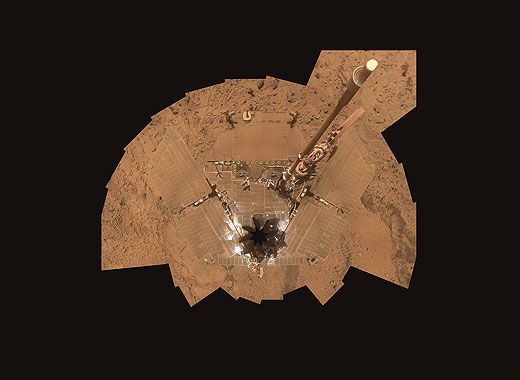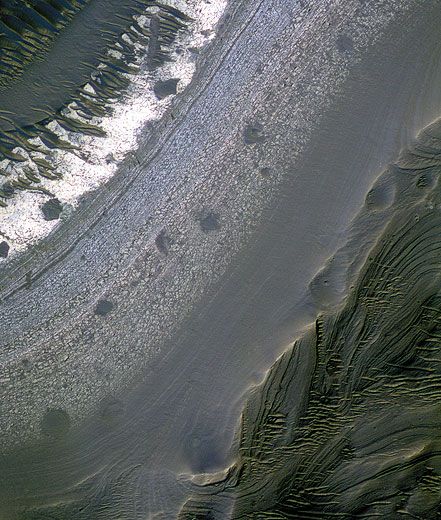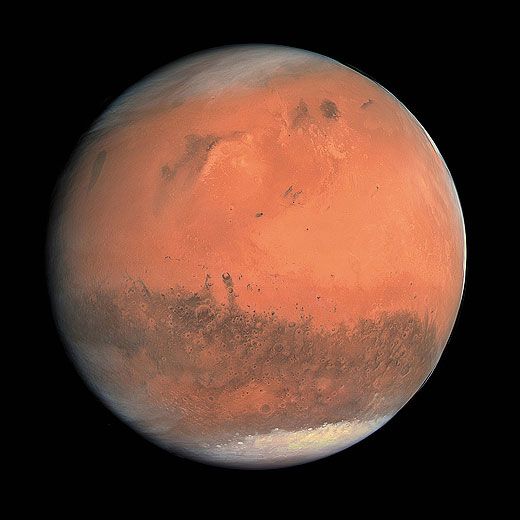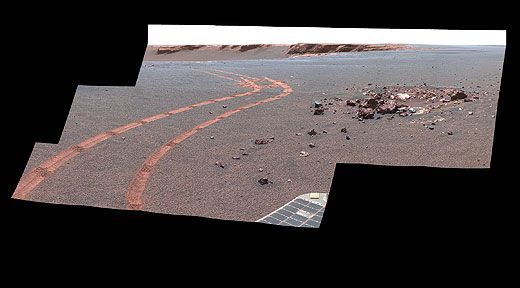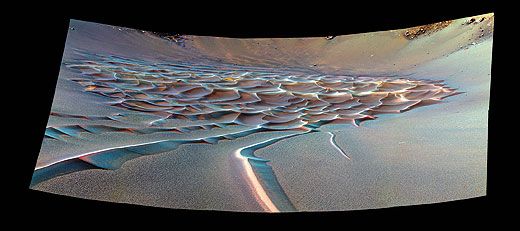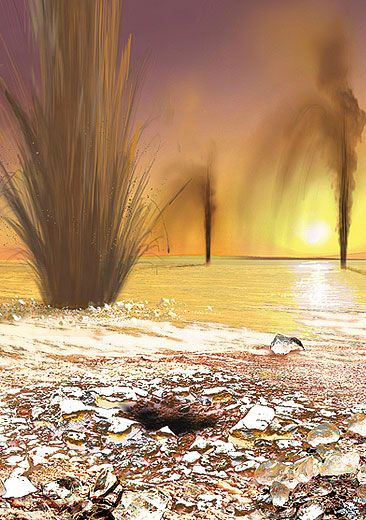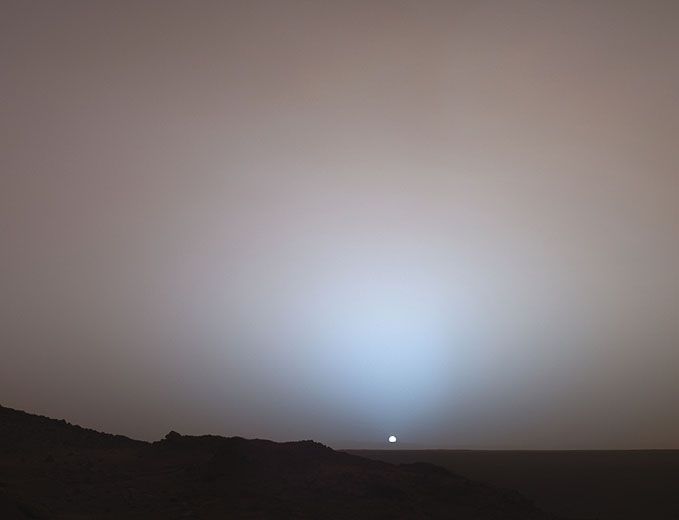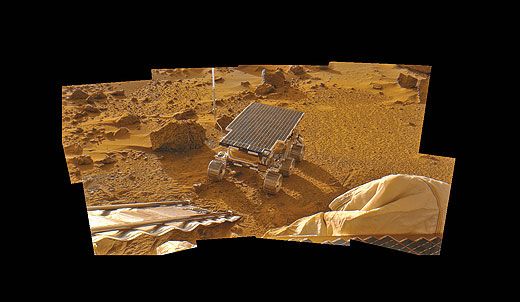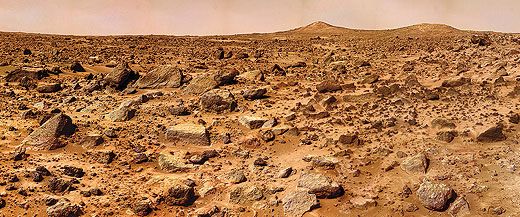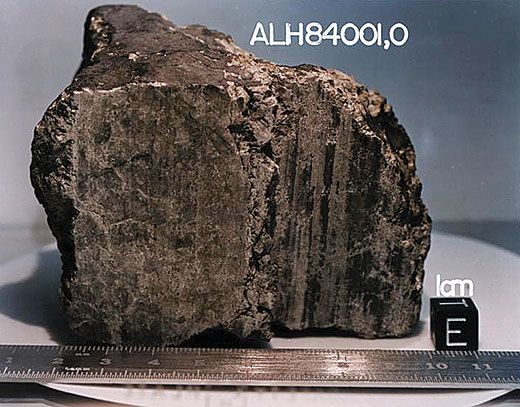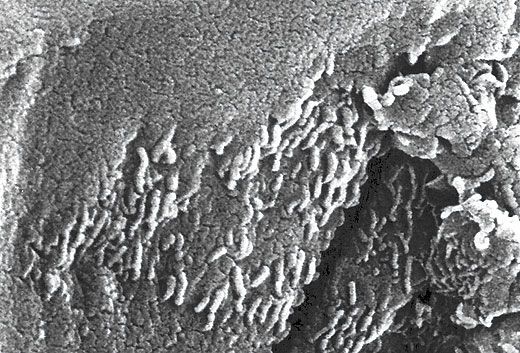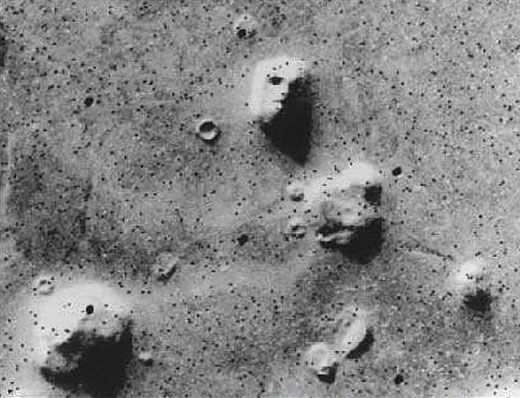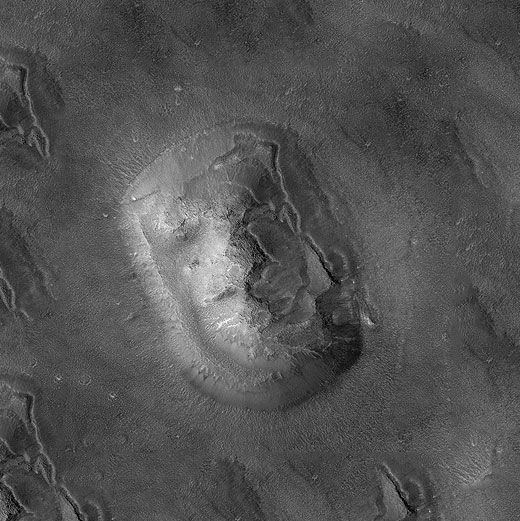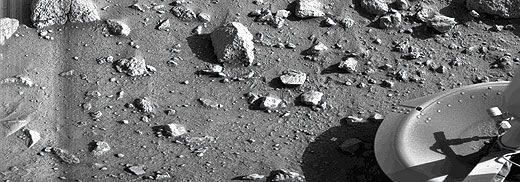Mars Journal
From the people who know Mars best, a collection of close encounters.
/https://tf-cmsv2-smithsonianmag-media.s3.amazonaws.com/filer/mars-journal-aug-2012-18_FLASH.jpg)
Whether it came during news coverage of the Viking missions more than three decades ago, or some time in the last six years, while the Mars Reconnaissance Orbiter has been beaming back pictures like a slugger at batting practice, most of us have had a Mars moment—a few seconds of awareness that the planet is a real place and that, with the proper precautions, we could go there. In order to make the most of the next opportunity for contemplation, as the latest rover Curiosity begins its exploration of the planet (see “Emissary,” p. 18), we’ve asked people who have spent their careers studying Mars or have focused their creative energies on it to tell us about their encounters. We hope you’ll add to our little red book, by leaving your own “Mars moments” in the comments.
~ The editors
 Gian Ori, planetary scientist, University d’Annunzio, Pescara, Italy. Director of the International Research School of Planetary Sciences.
Gian Ori, planetary scientist, University d’Annunzio, Pescara, Italy. Director of the International Research School of Planetary Sciences.
Memorable moment: When Viking 1 landed and started to operate, I was in the Sahara desert. After several days of geological work in the middle of nowhere, we reached Tamanrasset, Algeria, at that time still a fabulous and exotic desert town. There, from an old TV set I was able to see the first images from the surface. What an impression: to be in a remote place in the largest desert of the Earth, seeing the most technological achievement of the time. This experience left a mark, and I am now studying Mars.
Biggest surprise: The incredible variety of geological settings, the complex geological history, and consequently, the great possibility of discoveries, now and in the future.
Human landing: My optimistic guess is 2035.
 Scott Maxwell, rover driver, NASA’s Jet Propulsion Laboratory, Pasadena, California.
Scott Maxwell, rover driver, NASA’s Jet Propulsion Laboratory, Pasadena, California.
Memorable moment: The first time I ever drove a Mars rover, Spirit. It wasn’t much of a drive, just a few meters. I obsessively checked and rechecked everything, and in the end I went home—and couldn’t sleep. I remember just lying in bed staring wide-eyed at the ceiling, thinking that at that moment there was a robot on another planet, doing what I told it to do. It’s got to be as close as I’ll ever feel to what it was like to be Neil Armstrong or Buzz Aldrin standing on the moon at last.
Biggest surprise: I was unprepared for the fact that our two rovers would land in such different places. Spirit landed on the Mars you think of: Viking’s Mars, with a characteristic mix of rocks and dirt and distant hills. But Opportunity landed in a very different Mars: a parking lot, albeit one with some gigantic potholes (craters) and, later, speed bumps (ripples). Only recently, with its arrival at Endeavour Crater, has Opportunity begun to see yet another Mars, this one a mix of the terrain it’s seen before and something that looks just a bit like the Spirit side of the world.
Human landing: Landing humans on Mars has been 20 or 30 years away for the last 40 years or so. Unlike Apollo, bold talk is never followed up with hard cash. NASA has the engineering talent to turn that around, but there’s just not the political will in this country right now, and that hamstrings any effort, however well meant. All I know for sure is, if they’d put me on a rocket, I’d go.
 John Grant, geologist, Center for Earth and Planetary Studies, National Air and Space Museum. Co-chaired the community process that selected landing sites for the Spirit and Opportunity rovers, and the Mars Science Laboratory Curiosity.
John Grant, geologist, Center for Earth and Planetary Studies, National Air and Space Museum. Co-chaired the community process that selected landing sites for the Spirit and Opportunity rovers, and the Mars Science Laboratory Curiosity.
Memorable moment: I recall seeing Viking images of the Martian surface as a teenager, and realizing that planetary exploration was real and something I could participate in. I will never forget the first time I viewed Mars in 3-D using HiRISE [camera] images [from the Mars Reconnaissance Orbiter], and for the first time had the impression of what it might be like to actually stand on Mars.
Biggest surprise: The realization that there were once lakes on the surface. Although we’ve known about valleys and their relation to running water for some time, the identification of features requiring relatively large standing bodies of water is something that resonates with me. I grew up along the shores of Lake Champlain in New York, and that familiarity with lakes speaks to me about the possibility of habitable and more Earth-like conditions on Mars in the past.
Human landing: While I hope that humans will land on Mars in the next 20 years, I fear that it may take quite a bit longer.
 Elon Musk, founder and CEO, Space Exploration Technologies. Advocate of human colonization of Mars.
Elon Musk, founder and CEO, Space Exploration Technologies. Advocate of human colonization of Mars.
Memorable moment: I find the thought of people one day looking up from the surface of Mars and seeing the blue dot of Earth really inspiring.
Biggest surprise: The discovery in recent years that Martian soil can be used to grow Earth plants with very little effort, apart from warming it up and adding fertilizer.
Human landing: Approximately 2025.
 Matt Golombek, senior research scientist, Jet Propulsion Laboratory, Pasadena, California. Chief scientist on Mars Pathfinder mission and landing site scientist for the Mars Exploration Program.
Matt Golombek, senior research scientist, Jet Propulsion Laboratory, Pasadena, California. Chief scientist on Mars Pathfinder mission and landing site scientist for the Mars Exploration Program.
Memorable moment: The landing of Mars Pathfinder on July 4, 1997, will always be my most memorable encounter with Mars, when after years of work on the mission we received back stunning new images from the surface. We were surprised at the public reaction to the landing, with front-page headlines for a week and the largest Internet following in history at that time.
Biggest mystery: What was the early environment on Mars like? We have a lot of information to indicate an early wet and warmer environment on Mars. We still don’t know how wet and how warm and how long such conditions lasted. A Mars that was warm and wet for short intervals is very different from one that was warm and wet for many millions or even tens or hundreds of millions of years.
Human landing: No idea.
 Kim Stanley Robinson, author of The Mars Trilogy and 2312.
Kim Stanley Robinson, author of The Mars Trilogy and 2312.
Memorable Moment: One night I went to the Planetary Society’s headquarters in Pasadena, California, for a Ray Bradbury birthday party, and after we celebrated the great Martian, who was charming and inspirational as always, a lot of us drove up to Mt. Wilson, the old observatory in the mountains overlooking Los Angeles. We had to climb stairs to get up to the platform where one looked through the giant eyepiece coming out of the side of the telescope. The astronomers on hand said viewing conditions for Mars were poor, though they were getting great views of Neptune’s moon Triton. But they aimed the beast at Mars for our sakes, and when I looked through the eyepiece, as big as a cereal bowl, and caught sight of Mars, I was stunned to see it filled the whole viewing circle, and was floating there, red with dark patches that, yes, were connected by straight black lines! I had to laugh.
Biggest surprise: I remain surprised at how big Olympus Mons is, like a round Colorado some 21 kilometers [13 miles] higher than the surrounding terrain. The whole volcano has a circular escarpment, a cliff some 10 kilometers high all the way around it. I set my climbing story “Green Mars” on one point of this cliff, and I am still curious to know what the explanation for that escarpment is.
Human landing: My guess is we’ll have humans there in 2031.
 Candice Hansen-Koharcheck, Planetary Science Institute, Tucson, Arizona. Deputy principal investigator for the HiRISE camera on the Mars Reconnaissance Orbiter.
Candice Hansen-Koharcheck, Planetary Science Institute, Tucson, Arizona. Deputy principal investigator for the HiRISE camera on the Mars Reconnaissance Orbiter.
Memorable moment: Looking at images of the south polar region of Mars, taken just as the sun was rising at latitudes equivalent to the Antarctic circle on Earth, when we were trying to find a safe landing site for Mars Polar Lander. [The spacecraft, designed to study the soil and climate near the south pole, crashed into the surface of Mars in 1999.] The pictures showed an ice-covered surface with unearthly terrain, with unexpected spidery channels and cracks—not a safe, smooth spot to set down a small lander.
Biggest mystery: The way that Mars’ seasonal dry ice polar caps re-work and erode the surface today. With the HiRISE camera on the orbiter, we have been able to study the spring evaporation of the planet’s seasonal dry ice polar caps. [MRO, launched in August 2005, is searching for evidence that water flowed on the surface of Mars for a long time.] We think that gas trapped below the ice causes the ice to break and allow jets to erupt, but we really don’t know for sure. We have a lot of circumstantial evidence, but no plumes have actually been detected. What we do know is that spring on Mars is an active process reshaping the surface at high latitudes in today’s climate.
Human landing: Before the end of this century. I hope they are able to go to the polar regions and see the spring jets.
 Peter Smith, professor of planetary sciences, University of Arizona.
Peter Smith, professor of planetary sciences, University of Arizona.
Memorable moment: On July 4, 1997, Pathfinder landed safely on Chryse Planitia near the outwash plains of Ares Valles. The first set of images came down in a scrambled order and we began piecing them together, aligning boulder and horizon shots until an amazing scene was revealed, with a row of large stones nearly blocking a distant view of a twin peaked hill.
Biggest surprise: The Phoenix mission’s discovery of an abundance of perchlorate in the arctic soil. Perchlorate is a powerful oxidant and combusts organics at the high temperature of the Viking and Phoenix ovens. The combustion products would be perceived as water vapor, carbon dioxide, and some chloro-hydrocarbons that can be mistaken for cleaning agents. Viking saw these signatures, leading to the conclusion that the Martian soil is sterile. The truth awaits Curiosity, with its ability to measure organics without heating.
Human landing: My guess is we’ll have humans there in 2031.
 Ruslan Kuzmin, leading research scientist, Laboratory of Comparative Planetology, Vernadsky Institute of Geochemistry and Analytical Chemistry, Russian Academy of Sciences, Moscow.
Ruslan Kuzmin, leading research scientist, Laboratory of Comparative Planetology, Vernadsky Institute of Geochemistry and Analytical Chemistry, Russian Academy of Sciences, Moscow.
Memorable moment: My first encounter with Mars took place in 1956 as a middle school student, when I attended a summer camp near Moscow. There, I paid attention to the red star, which twinkled beautifully in the evening sky. That led me to take courses in astronomy, read science fiction books about Mars, and study maps of the planet made from telescopic observations. My favorite book was The Martian Chronicles by Ray Bradbury.
Biggest surprise: The images of Mars taken by Mariner 9 in 1971. The pictures of a dry riverbed like the Nirgal Vallis and the huge canyons and volcanoes just staggered me. It became clear that Mars has many Earth-like landscapes. Besides the mystery of whether there ever was primitive life, another important question is what climatic conditions existed on Mars in the geologic period between 4 billion and 3.6 billion years ago?
Human landing: No earlier than 2039 or 2040.
 Mary Roach, author of Packing for Mars.
Mary Roach, author of Packing for Mars.
Memorable moment: Sometime in 2009, I visited the meteorite collection at the Johnson Space Center in Houston. Mike Zolensky, a man with the enviable job title Curator of Cosmic Dust, handed me a Mars meteorite as heavy as a bowling ball. I stood there making an expression I’m sure I’d never before had occasion to make. The meteorite wasn’t especially beautiful. Give me a chunk of asphalt and some shoe polish and I can make you a simulated Mars meteorite. What I can’t possibly simulate for you is the feeling of holding a 20-pound divot of Mars in your hands.
Biggest surprise: How familiar, how Earthly, the Martian surface looks. As my agent said when I sent him a panorama taken by the rover Spirit, “Looks like the outskirts of Las Vegas.”
Human landing: Best guess, 2035.
 Michael Collins, Gemini and Apollo astronaut and author, Mission to Mars.
Michael Collins, Gemini and Apollo astronaut and author, Mission to Mars.
Of the many authors who have imagined human missions to Mars, former astronaut Michael Collins was the first to speak with the authority of someone who had traveled in space. He published his book Mission to Mars in 1990, four years after NASA suffered its first space shuttle accident, but on many pages it reads as though it were written last week—in its assessment, for example, that a lack of political will to pay the high cost of a human trip to Mars is more daunting than the technological challenge. “The only thing I know for certain,” Collins writes, “is that starting a human colony on a second planet will cost much less than the weapons we buy to destroy the first one.”
Recently, Collins spoke about his book and his outlook on a human mission to Mars.
Air & Space: You sometimes joked that the Apollo program sent you to the wrong planet. How did your fascination with Mars begin?
Mars has just always seemed to be a more interesting place than the moon. It’s the closest thing to a sister planet that we have, and if you put two photographs up on a wall—one of Mars and one of the moon—with a little blurb saying This is the moon and this is what it’s all about and This is Mars and what it’s all about, and you poked someone in the ribs, and said, “Choose!” I would say 99 out of 100 people would choose Mars.
You published your book Mission to Mars 22 years ago. Do you think we are any closer to a human mission to Mars than we were in 1990?
No, I think we’re probably farther away today than we were 20 years ago. Because the current White House and the current NASA administration don’t really have a clear-cut vision of where they want to go. Perhaps to some asteroid is about as close as they get. And I think without a very clear vision and an accompanying timetable, we’re just not going to get there any time soon.
What have you thought of the images from the rovers Spirit and Opportunity?
I thought less about Mars and more about the machine. I thought those two machines were marvels of engineering, and to see them and their tracks was very enjoyable to me. I think the disappointment is that I thought we’d get a more extensive chemical analysis of the Martian surface with some sort of an indication fairly clearly one way or the other whether there was evidence of life present or past—or whether that should be ruled out.
When you addressed Congress after your Apollo mission, and again in 2009, in your press release on Apollo’s 40th anniversary, you expressed hope for a manned Mars mission. That’s a long time to keep hope alive. Is there any reason for optimism?
If you take a very long, long view, I like to steal the phrase “outward bound.” I think humankind will go away from the surface of this planet and go outward bound, exploring the solar system and perhaps even beyond. So I’m optimistic in the very, very long run. I think the urge to go to different places will continue. I think the urge will intensify: to see, to touch, to smell, to feel. But in the short or intermediate term, no. I don’t see anything too hopeful. It’s too expensive right now.
So can you guess when humans will land on Mars?
No time soon. Not in my lifetime certainly.
Editors’ Picks
”Every space mission to a new place—whether human or robotic—has to carry a camera,” Cornell University astronomer Jim Bell writes in the preface to his book Postcards from Mars, which gathers images from the rovers Spirit and Opportunity. “These cameras are the eyes that have to tell the stories of new alien worlds to the people back home who couldn’t go.”
We asked the scientists and writers who contributed to our Mars Journal to pick their favorite photos of Mars, the pictures that best tell the planet’s story. Some liked images that evoke thoughts of a violently formed, forbidding planet. Others preferred pictures of a more placid, almost serene place. Together, they reveal a portrait of a world that is in some ways alien and in other ways as familiar as some mountain and desert vistas on Earth.
The story of Mars, however, would be incomplete without a few images that in their own way and time stirred up new interest in our neighboring planet. We picked several that generated headlines worldwide and challenged our previous conceptions of Mars.
—The editors
